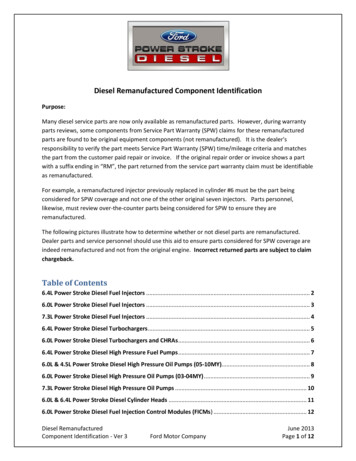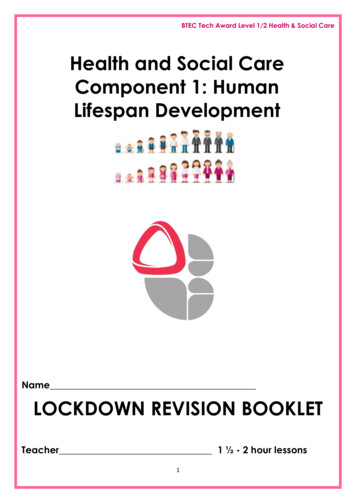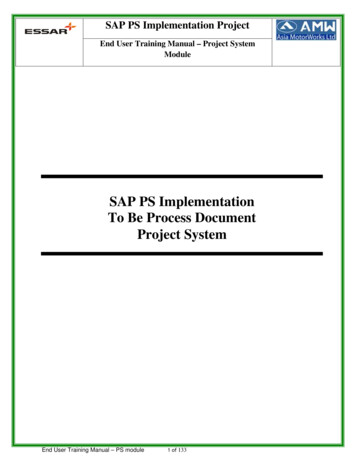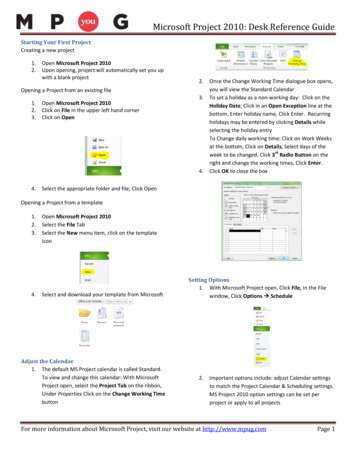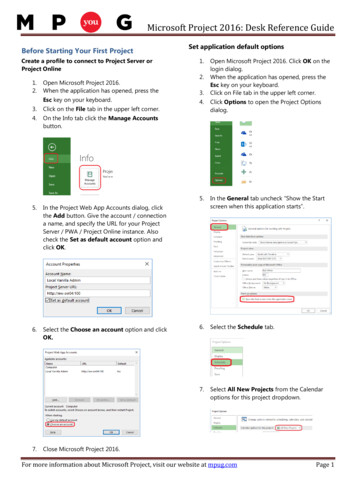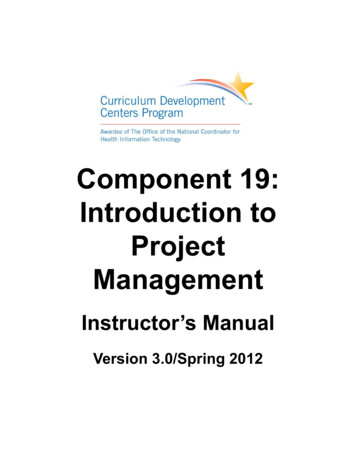
Transcription
Component 19:Introduction toProjectManagementInstructor’s ManualVersion 3.0/Spring 2012
Notes to InstructorsThis Instructor’s Manual is a resource for instructors using the Introductionto Project Management component. Each component is broken down intounits, each of which will include the following elements: Learning objectivesSuggested student readings, texts, reference links tosupplement the narrated PowerPoint slidesLectures (voiceover PowerPoint in Flash format); PowerPointslides (Microsoft PowerPoint format), lecture transcripts(Microsoft Word format); and audio files (MP3 format) foreach lectureSelf-assessment questions reflecting Unit Objectives withanswer keys and/or expected outcomesApplication Activities (e.g., discussion questions,assignments, projects) with instructor guidelines, answerkeys and/or expected outcomesSeparate materials are provided with units 3, 5, and 7 so students canhave hands-on project management experience. Additional projectmanagement templates and materials are available with unit 3. Thesematerials can be utilized throughout this component.This material provides students with both analysis of and hands-onapplication of project management tools and techniques to real-life healthIT scenariosHealth IT Workforce CurriculumIntroduction to Project ManagementVersion 3.0/Spring 20122This material was developed by Johns Hopkins University, funded by the Department of Health and Human Services, Office ofthe National Coordinator for Health Information Technology under Award Number IU24OC000013.
ContentsNotes to Instructors .2Component Overview.4Component Authors .5Disclaimer.7Component 19/Unit 1.8Component 19/Unit 2.11Component 19/Unit 3.14Component 19/Unit 4.17Component 19/Unit 5.20Component 19/Unit 6.23Component 19/Unit 7 .26Component 19/Unit 8.29Component 19/Unit 9.33Component 19/Unit 10.36Component 19/Unit 11 .40Glossary.43Creative Commons Attribution-NonCommercialShareAlike 3.0 Unported .45Health IT Workforce CurriculumIntroduction to Project ManagementVersion 3.0/Spring 20123This material was developed by Johns Hopkins University, funded by the Department of Health and Human Services, Office ofthe National Coordinator for Health Information Technology under Award Number IU24OC000013.
Component OverviewAn understanding of project management tools and techniques that resultsin the ability to create and follow a project management plan.Component ObjectivesAt the completion of this component, the student will be able to: Describe factors that are critical to project success.Develop a comprehensive project management plan.Define project scope that reflects stakeholder perspectives andproject requirements.Prepare an effective work breakdown structure.Differentiate project life cycle models based on projectcharacteristics.Develop estimates for project cost and schedule.Apply tools and techniques to manage project scope, time, andbudget.Plan and implement effective communications with the project teamand stakeholders.Differentiate roles of project team members.Select and apply appropriate tools and techniques for riskmanagement, quality management, and change management.Health IT Workforce CurriculumIntroduction to Project ManagementVersion 3.0/Spring 20124This material was developed by Johns Hopkins University, funded by the Department of Health and Human Services, Office ofthe National Coordinator for Health Information Technology under Award Number IU24OC000013.
Component AuthorsJohns Hopkins University, Baltimore, MDWilliam Agresti, PhD, Johns Hopkins Carey Business SchoolWilliam W. Agresti, Ph.D. is a Professor in the Carey Business Schoolat Johns Hopkins University. His research, professional, and teachinginterests are in project management, systems development, and discoveryinformatics. He previously held senior technical leadership positions inthe IT industry at CSC and MITRE Corporation and was Program Directorfor Experimental Software Systems research at the National ScienceFoundation. He has over one hundred publications, including the bestselling New Paradigms for Software Development, the widely distributedNASA Manager’s Handbook for Software Development, and the recentbook, Communicating as IT Professionals. He received a Ph.D. inComputer Science from New York University.Theron Feist, MA, Johns Hopkins University School of NursingTheron Feist, MA is Instructional Technology Manager for the JohnsHopkins University School of Nursing. Previously, he held positions inthe Johns Hopkins Enterprise Information Technology group managingsoftware development projects and at the Center for EducationalResources, providing faculty instructional technology support. He has15 years of project management experience in a variety of educationalsettings. In this 15 year time period, he has developed numerous coursesand managed many large and complex projects building instructionaltechnology infrastructure and building software programs. Mr. Feist isan Adjunct Professor at ITT Technical Institute where he teaches projectmanagement and software development courses.Mary McNally, PMP, Harford Community CollegeMary McNally, PMP, is recognized as “America’s Authority on PMPCertification.” With over 30 years of project management and instructionalexperience, Mary established Project Training Plus, LLC, an approvedprovider of project management training by the Project ManagementInstitute (PMI R.E.P.). She specializes in helping people successfullypass the PMP & CAPM credential exams. Mary has a BA in Science& Mathematics, MS in Biology, MA in Management, and MastersCertificate in Project Management. Mary is an ardent supporter of projectHealth IT Workforce CurriculumIntroduction to Project ManagementVersion 3.0/Spring 20125This material was developed by Johns Hopkins University, funded by the Department of Health and Human Services, Office ofthe National Coordinator for Health Information Technology under Award Number IU24OC000013.
management education and training. She has held key PMI BaltimoreChapter leadership roles as the VP of Membership and VP CertificationPrograms.James Smith, RN, MSITS, Johns Hopkins HospitalJames E. Smith, MSITS, RN is Project Lead for Sunrise OrdersImplementation, Clinical Quality and Informatics at The Johns HopkinsHospital in Baltimore, Maryland, USA. He earned his BSN from theWashington Adventist University and his Master’s of Science from JohnsHopkins University. Mr. Smith has been in the healthcare IT field since1996 and has implemented many different kinds of healthcare IT andhealthcare financial software programs over the last 14 years.Gabrielle B Haskins, PMPGabrielle Haskins, PMP, has two Master Certificates from GeorgeWashington University, one in Information Technology ProjectManagement, and one in Project Management, PMP certification fromPMI 2009. In 2010 she was a lead faculty for the Health InformationTechnology project, at Lansing Community College and was responsiblefor adapting and creating the material for the workforce curriculum forthe six roles from ONC/HHS, specifically preparing materials for theImplementation Project Manager and Technical Implementation SupportSpecialist.Lecture Narration/Sound EngineerRaland Technologies LLC1387 Fairport RoadSuite 1050 Fairport, NY 14450David Flass – Project ManagerHealth IT Workforce CurriculumIntroduction to Project ManagementVersion 3.0/Spring 20126This material was developed by Johns Hopkins University, funded by the Department of Health and Human Services, Office ofthe National Coordinator for Health Information Technology under Award Number IU24OC000013.
DisclaimerThese materials were prepared under the sponsorship of an agency ofthe United States Government. Neither the United States Governmentnor any agency thereof, nor any of their employees, makes any warranty,express or implied, or assumes any legal liability or responsibility for theaccuracy, completeness, or usefulness of any information, apparatus,product, or process disclosed, or represents that its use would not infringeprivately owned rights. Reference herein to any specific commercialproduct, process, or service by trade name, trademark, manufacturer,or otherwise does not necessarily constitute or imply its endorsement,recommendation, or favoring by the United States Government or anyagency thereof. The views and opinions of authors expressed herein donot necessarily state or reflect those of the United States Government orany agency thereof.Likewise, the above also applies to the Curriculum DevelopmentCenters (including Columbia University, Duke University, Johns HopkinsUniversity, Oregon Health & Science University, University of Alabama atBirmingham, and their affiliated entities).Health IT Workforce CurriculumIntroduction to Project ManagementVersion 3.0/Spring 20127This material was developed by Johns Hopkins University, funded by the Department of Health and Human Services, Office ofthe National Coordinator for Health Information Technology under Award Number IU24OC000013.
Component 19/Unit 1Unit TitleAn Overview of Health IT ProjectsUnit DescriptionStudents will receive a broad overview of project management includingsome distinctive characteristics of health IT projects. This unit includesseveral real scenarios to illustrate the diversity of projects in health IT.Unit ObjectivesBy the end of this unit the student will be able to:1. Review the history of project management.2. Define what a project is.3. Define project management.4. Identify reasons that more organizations are implementingHIT projects.5. Identify key characteristics for project success and failure.6. Describe the range and characteristics of health IT projects.Unit Topics / Lecture Titles1.1 – Health IT Scenarios1.2 – What Is Project Management?1.3 – Reasons for Projects1.4 – Role of the Project Manager1.5 – Reasons Success/FailureUnit References(All links accessible as of 1/1/2012)Lecture 1a1. A User’s Manual to the PMBOK Guide, Stackpole. Wiley:2010.Hoboken, NJ2. Avova. Project Management. c2006-2011. Available nt *3. Health Care Projects: PMI Healthcare Special Interest Grouphttp://www.pmihealthcare.org/4. Houston S, Bove LA. Project management for healthcareinformatics. Springer Science Business Media, LLC; 2010*Indicates this link is no longer functional.Health IT Workforce CurriculumIntroduction to Project ManagementVersion 3.0/Spring 20128This material was developed by Johns Hopkins University, funded by the Department of Health and Human Services, Office ofthe National Coordinator for Health Information Technology under Award Number IU24OC000013.
5. Infoglow. Iterative & Incremental Software Development: A BriefHistory. c2007-2011. Available from:http://www.infoglow.com/index.php?p res briefe history6. Kerzner H. Project management: a systems approach to planning,scheduling, and controlling. 10th ed. Wiley; 2009.7. Knowledgerush. Project Management. c2009. Available from: ct management/ *8. Projects: Project Management Institute (PMI), and its Guide to theProject Management Body of Knowledge (PMBOK Guide) , 4thEd., 2008.9. Schwalbe K. Information technology project management (withMicrosoft Project 2007 CD-ROM). 6th ed.; 2009.10. Whitten N. Neal Whitten’s let’s talk! more no-nonsense advice forproject success. Management concepts; 2007.11. Wiefling K. Scrappy project management, 12 predictable &avoidable pitfalls every project faces. 1st ed. Happy About; 2007.12. Wikia. Engineering: Project Management. Available from:http://engineering.wikia.com/wiki/Project management13. Wikipedia. Project Management. c2011. Available from:http://en.wikipedia.org/wiki/Project management14. Wysocki, RK . Effective project management: traditional, agile,extreme. 5th Edition. New York: Wiley; 2009.Lecture 1a ImagesSlide 9: Flow chart of Process Areas. Image courtesy Wikipedia, CreativeCommons.Available from: http://en.wikipedia.org/wiki/Project lifecycle#Project development stagesSlide 12. 1 :Iterative Life Cycle. Craetive Commons Wikipedia::User:Westerhoff. ive development model V2.jpgSlide 12.2 :Agile Life Cycle Creative Commons VersionOne, Inc. (andtrimmed by User:Mdd). Available from: http://en.wikipedia.org/wiki/File:Agile Software Development methodology.jpgLecture 1b1. A User’s Manual to the PMBOK Guide, Stackpole. Wiley:2010.Hoboken, NJ2. Avova. Project Management. c2006-2011. Available nt*Indicates this link is no longer functional.Health IT Workforce CurriculumIntroduction to Project ManagementVersion 3.0/Spring 20129This material was developed by Johns Hopkins University, funded by the Department of Health and Human Services, Office ofthe National Coordinator for Health Information Technology under Award Number IU24OC000013.
3. Health Care Projects: PMI Healthcare Special Interest Group(http://www.pmihealthcare.org/ *)4. Houston S, Bove LA. Project management for healthcareinformatics. Springer Science Business Media, LLC; 20105. Infoglow. Iterative & Incremental Software Development: A BriefHistory. c2007-2011. Available from:http://www.infoglow.com/index.php?p res briefe history6. Kerzner H. Project management: a systems approach to planning,scheduling, and controlling. 10th ed. Wiley; 2009.7. Knowledgerush. Project Management. c2009. Available Projectmanagement/ *8. Projects: Project Management Institute (PMI), and its Guide to theProject Management Body of Knowledge (PMBOK Guide) , 4thEd., 2008.9. Schwalbe K. Information technology project management (withMicrosoft Project 2007 CD-ROM). 6th ed.; 2009.10. Whitten N. Neal Whitten’s let’s talk! more no-nonsense advice forproject success. Management concepts; 2007.11. Wiefling K. Scrappy project management, 12 predictable &avoidable pitfalls every project faces. 1st ed. Happy About; 2007.12. Wikia. Engineering: Project Management. Available from:http://engineering.wikia.com/wiki/Project management13. Wikipedia. Project Management. c2011. Available from:http://en.wikipedia.org/wiki/Project management14. Wysocki, RK . Effective project management: traditional, agile,extreme. 5th Edition. New York: Wiley; 2009.Student Application Activitiescomp19 unit1 activity.doccomp19 unit1 activity key.doccomp19 unit1 self assess.doccomp19 unit1 self assess key.doc*Indicates this link is no longer functional.Health IT Workforce CurriculumIntroduction to Project ManagementVersion 3.0/Spring 201210This material was developed by Johns Hopkins University, funded by the Department of Health and Human Services, Office ofthe National Coordinator for Health Information Technology under Award Number IU24OC000013.
Component 19/Unit 2Unit TitleProject Life CyclesUnit DescriptionThis unit provides an overview of various project life cycles so thatstudents can assess their appropriateness for use depending oncharacteristics of a project. Students examine processes, knowledgeareas, and organizational influences that are critical to successful projectmanagement.Unit ObjectivesBy the end of this unit the student will be able to:1. Identify process groups and knowledge areas used in projectmanagement.2. Differentiate linear, iterative, adaptive, and agile project life cycles.3. Relate life cycle phases to reviews, milestones, and deliverables.4. Compare various organizational structures as contexts for managingprojects.Unit Topics / Lecture Titles2.1 – Project Management Elements2.2 – Life Cycles2.3 – Phases2.4 – OrganizationsUnit References(All links accessible as of 1/1/2012)Lecture 2a1. Highsmith, JA. (2009) Agile Project Management: creatinginnovative products. 2nd ed; Boston: Pearson Education.2. Houston S, Bove LA. (2010) Project Management for HealthcareInformatics. New York: Springer Science Business Media, LLC.3. Kerzner H. (2009) Project Management: a Systems Approach toPlanning, Scheduling, and Controlling. 10th ed. Hoboken, NJ: Wiley.4. Project Management Institute, A Guide to the Project ManagementBody of Knowledge. 4th ed (2008).Newtown Square, PA: PMI.*Indicates this link is no longer functional.Health IT Workforce CurriculumIntroduction to Project ManagementVersion 3.0/Spring 201211This material was developed by Johns Hopkins University, funded by the Department of Health and Human Services, Office ofthe National Coordinator for Health Information Technology under Award Number IU24OC000013.
5. Whitten N. Neal (2007).Whitten’s Let’s Talk! More No-nonsenseAdvice for Project Success. Vienna, VA.:Management ConceptsInc.6. Wysocki, RK .(2009).Effective Project Management: traditional,agile, extreme. 5th Edition. New York: Wiley.Lecture 2a ImagesSlide 9: Processes and Process Groups. Courtesy Johns HopkinsUniversity StaffSlide 14: Reference Models for Project Life Cycles. Courtesy JohnsHopkins University StaffLecture 2b1. Highsmith, JA. (2009) Agile Project Management: Creatinginnovative products. 2nd ed; Boston: Pearson Education.2. Houston S, Bove LA. (2010) Project Management for HealthcareInformatics. New York: Springer Science Business Media, LLC.3. Kerzner H. (2009) Project Management: a Systems Approach toPlanning, Scheduling, and Controlling. 10th ed. Hoboken, NJ: Wiley.4. Project Management Institute, A Guide to the Project ManagementBody of Knowledge. 4th ed (2008).Newtown Square, PA: PMI.5. Whitten N. Neal (2007).Whitten’s Let’s Talk! More No-nonsenseAdvice for Project Success. Vienna, VA: Management ConceptsInc.6. Wysocki, RK .(2009).Effective Project Management: traditional,agile, extreme. 5th Edition. New York: Wiley.Lecture 2b ImagesSlide 5: Iterative Life Cycle Models. Image courtesy Johns HopkinsUniversity Staff.Slide 7: Iterative Life Cycle Model: Example 1. Courtesy of: Theron FeistSlide 8: Iterative Life Cycle Model: Example 2. Courtesy of: Theron FeistSlide 9: Iterative Life Cycle Model: Example 3. Courtesy of: Theron FeistLecture 2c1. Highsmith, JA. (2009) Agile Project Management: creatinginnovative products. 2nd ed; Boston: Pearson Education.2. Houston S, Bove LA. (2010) Project Management for HealthcareInformatics. New York: Springer Science Business Media, LLC.3. Kerzner H. (2009) Project Management: a Systems Approach toPlanning, Scheduling, and Controlling. 10th ed. Hoboken, NJ: Wiley.*Indicates this link is no longer functional.Health IT Workforce CurriculumIntroduction to Project ManagementVersion 3.0/Spring 201212This material was developed by Johns Hopkins University, funded by the Department of Health and Human Services, Office ofthe National Coordinator for Health Information Technology under Award Number IU24OC000013.
4. Project Management Institute, A Guide to the Project ManagementBody of Knowledge. 4th ed (2008).Newtown Square, PA: PMI.5. Whitten N. Neal (2007).Whitten’s Let’s Talk! More No-nonsenseAdvice for Project Success. Vienna, VA.:Management ConceptsInc.6. Wysocki, RK .(2009).Effective Project Management: traditional,agile, extreme. 5th Edition. New York: Wiley.Lecture 2c ImagesSlide 3: Example of a Life Cycle Model: Courtesy of: Theron FeistSlide 11: Examples of Deliverables and Management Reviews in a ProjectLife Cycle. Courtesy of: Theron FeistLecture 2d1. Houston S, Bove LA. (2010) Project Management for HealthcareInformatics. New York: Springer Science Business Media, LLC.2. Kerzner H. (2009) Project Management: a Systems Approach toPlanning, Scheduling, and Controlling. 10th ed. Hoboken, NJ: Wiley.3. Project Management Institute, A Guide to the Project ManagementBody of Knowledge. 4th ed (2008).Newtown Square, PA: PMI.4. Whitten N. Neal (2007).Whitten’s Let’s Talk! More No-nonsenseAdvice for Project Success. Vienna, VA.: Management Concepts Inc.5. Wysocki, RK .(2009).Effective Project Management: traditional,agile, extreme. 5th Edition. New York: Wiley.Lecture 2d ImagesSlide 7. “Project Management in a Project-Based Organization.” Imagecourtesy Johns Hopkins University School of NursingSlide 8. “Project Management in a Matrix Organization.” Image courtesyJohns Hopkins University School of NursingSlide 9. “Project Management in a Project-Based Organization.” Courtesyof: Theron FeistStudent Application Activitiescomp19 unit2 activity.doccomp19 unit2 activity key.doccomp19 unit2 self assess.doccomp19 unit2 self assess key.doc*Indicates this link is no longer functional.Health IT Workforce CurriculumIntroduction to Project ManagementVersion 3.0/Spring 201213This material was developed by Johns Hopkins University, funded by the Department of Health and Human Services, Office ofthe National Coordinator for Health Information Technology under Award Number IU24OC000013.
Component 19/Unit 3Unit TitleProject Selection and InitiationUnit DescriptionStudents learn what is necessary to get projects off to a strong start.Critical activities are to prepare a project charter and to identify andengage the project stakeholders.Unit ObjectivesBy the end of this unit the student will be able to:1. Identify the key elements of a project environment and HITlandscape.2. Outline the needs for projects, how and why they areselected and initiated.3. Construct a project charter.4. Identify project stakeholders.5. Generate a stakeholder register.Unit Topics / Lecture Titles3.1 – Project Initiation3.2 – Project Charter3.3 – Stakeholders & Stakeholder RegisterUnit References(All links accessible as of 1/1/2012)Lecture 3a1. Health Information Technology Curriculum, Component 2: TheCulture of Health Care (2012) Office of the National Coordinator forHealth Information Technology. Available from:http://www.onc-ntdc.org2. Houston S, Bove LA. (2010) Project Management for HealthcareInformatics. New York: Springer Science Business Media, LLC.3. Kerzner H. (2009) Project Management: a Systems Approach toPlanning, Scheduling, and Controlling. 10th ed. Hoboken, NJ: Wiley.4. Project Management Institute, A Guide to the Project ManagementBody of Knowledge. 4th ed (2008).Newtown Square, PA: PMI.*Indicates this link is no longer functional.Health IT Workforce CurriculumIntroduction to Project ManagementVersion 3.0/Spring 201214This material was developed by Johns Hopkins University, funded by the Department of Health and Human Services, Office ofthe National Coordinator for Health Information Technology under Award Number IU24OC000013.
5. Scwalbe K. (2009) Information technology project management (withMicrosoft Project 2007 CD-ROM). 6th ed.; Boston: Cenage Learning.6. Stackpole C. (2009). A Project Manager’s Book of Forms: ACompanion to the PMBOK Guide. Hoboken, N.J: Wiley;7. Whitten N. Neal (2007).Whitten’s Let’s Talk! More No-nonsenseAdvice for Project Success. Vienna, VA: Management Concepts Inc.8. Wysocki, RK .(2009).Effective Project Management: traditional, agile,extreme. 5th Edition. New York: Wiley.Lecture 3a ImagesSlide 12. View of the Future of healthcare. Image courtesy of the USDepartment of Health and Human Services.Slide 15. SWOT Analysis. Creative Commons: Wikipedia. Available from:http://en.wikipedia.org/wiki/SWOT analysisLecture 3b1. Houston S, Bove LA. (2010) Project Management for HealthcareInformatics. New York: Springer Science Business Media, LLC.2. Kerzner H. (2009) Project Management: a Systems Approach toPlanning, Scheduling, and Controlling. 10th ed. Hoboken, NJ: Wiley.3. Project Management Institute, A Guide to the Project ManagementBody of Knowledge. 4th ed (2008).Newtown Square, PA: PMI.4. Scwalbe K. (2009) Information technology project management(with Microsoft Project 2007 CD-ROM). 6th ed.; Boston: CenageLearning.5. Stackpole C. (2009). A Project Manager’s Book of Forms: ACompanion to the PMBOK Guide. Hoboken, N.J: Wiley;6. Whitten N. Neal (2007).Whitten’s Let’s Talk! More No-nonsenseAdvice for Project Success. Vienna, VA: Management ConceptsInc.7. Wysocki, RK .(2009).Effective Project Management: traditional,agile, extreme. 5th Edition. New York: Wiley.Lecture 3b ImagesSlide 12. View of the Future of healthcare. Image courtesy of the USDepartment of Health and Human Services.Slide 15. SWOT Analysis. Creative Commons: Wikipedia. Available from:http://en.wikipedia.org/wiki/SWOT analysis*Indicates this link is no longer functional.Health IT Workforce CurriculumIntroduction to Project ManagementVersion 3.0/Spring 201215This material was developed by Johns Hopkins University, funded by the Department of Health and Human Services, Office ofthe National Coordinator for Health Information Technology under Award Number IU24OC000013.
Lecture 3c1. Agar. Culture: Can You Take It Anywhere? Invited LecturePresented at the Gevirtz Graduate School of Education, HoustonS, Bove LA. (2010) Project Management for HealthcareInformatics. New York: Springer Science Business Media, LLC.2. Kerzner H. (2009) Project Management: A Systems Approach toPlanning, Scheduling, and Controlling. 10th ed. Hoboken, NJ:Wiley.3. Project Management Institute, A Guide to the Project ManagementBody of Knowledge. 4th ed (2008).Newtown Square, PA: PMI.4. Scwalbe K. (2009) Information technology project management(with Microsoft Project 2007 CD-ROM). 6th ed.; Boston: CenageLearning.5. Stackpole C. (2009). A Project Manager’s Book of Forms: ACompanion to the PMBOK Guide. Hoboken, N.J.:Wiley;6. Whitten N. Neal (2007).Whitten’s Let’s Talk! More No-nonsenseAdvice for Project Success. Vienna, VA: Management ConceptsInc.7. Wysocki, RK (2009). Effective Project Management: Traditional,agile, extreme. 5th Edition. New York: Wiley.Additional Handouts:comp19 unit3 project application.doccomp19 unit3 project charter.doccomp19 unit3 stakeholder register.doccomp19 unit3 change request template.doccomp19 unit3 lessons learned.doccomp19 unit3 project initiation worksheet.doccomp19 unit3 project status update.doccomp19 unit3 risk response plan.doccomp19 unit3 risk managment plan.doccomp19 unit3 statement of work.doccomp19 unit3 SWOT.docStudent Application Activitiescomp19 unit3 activity.doccomp19 unit3 activity key.doccomp19 unit3 self assess.doccomp19 unit3 self assess key.doc*Indicates this link is no longer functional.Health IT Workforce CurriculumIntroduction to Project ManagementVersion 3.0/Spring 201216This material was developed by Johns Hopkins University, funded by the Department of Health and Human Services, Office ofthe National Coordinator for Health Information Technology under Award Number IU24OC000013.
Component 19/Unit 4Unit TitleProject Planning OverviewUnit DescriptionIn this unit, students will learn how to effectively plan projects andto develop a project management plan. Several key documentationcomponents will be introduced.Unit ObjectivesBy the end of this unit the student will be able to:1. Identify the importance and purpose of effective planning.2. Identify and describe each component of the projectmanagement plan.3. Define and prepare project planning documents.Unit Topics / Lecture Titles4.1 – Project Management4.2 – Project Management Processes and Groups4.3 – Planning a Project4.4 – Project Planning ProcessesUnit References(All links accessible as of 1/1/2012)Lecture 4a1. Health Information and Management System Society. Chicago, IL.2010. Available from: http://www.himss.org2. Highsmith JA. (2009). Agile Project Management: CreatingInnovative Products. 2nd ed.; Boston: Addison-Wesley.3. HITECH Answers. 2010. Available from: http://hitechanswers.net/4. Houston S, Bove LA. (2010) Project Management for HealthcareInformatics. New York: Springer Science Business Media, LLC.5. Kerzner H. (2009) Project Management: a Systems Approachto Planning, Scheduling, and Controlling. 10th ed. Hoboken, NJ:Wiley. mHealth Initiative. Boston, MA. 2009. Available from:http://www.mobih.org/ *6. Project Management Institute, A Guide to the Project ManagementBody of Knowledge. 4th ed (2008).Newtown Square, PA: PMI.*Indicates this link is no longer functional.Health IT Workforce CurriculumIntroduction to Project ManagementVersion 3.0/Spring 201217This material was developed by Johns Hopkins University, funded by the Department of Health and Human Services, Office ofthe National Coordinator for Health Information Technology under Award Number IU24OC000013.
7. Scwalbe K. (2009) Information Technology Project Management(with Microsoft Project 2007 CD-ROM). 6th ed.; Boston: CenageLearning.8. Stackpole C. (2009). A Project Manager’s Book of Forms: ACompanion to the PMBOK Guide. Hoboken, NJ Wiley.9. Whitten N. Neal (2007).Whitten’s Let’s Talk! More No-nonsenseAdvice
Project Management Body of Knowledge (PMBOK Guide) , 4 th Ed., 2008. 9. Schwalbe K. Information technology project management (with Microsoft Project 2007 CD-ROM). 6th ed.; 2009. 10. Whitten N. Neal Whitten’s let’s talk! more no-nonsense advice for project success. Management concepts; 2007. 11. Wiefli



